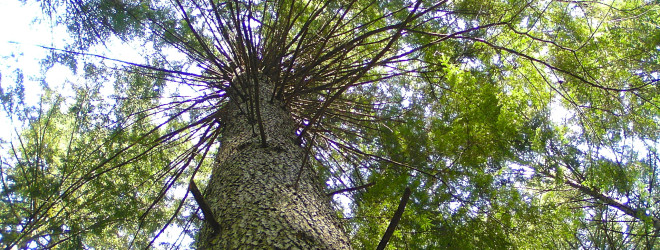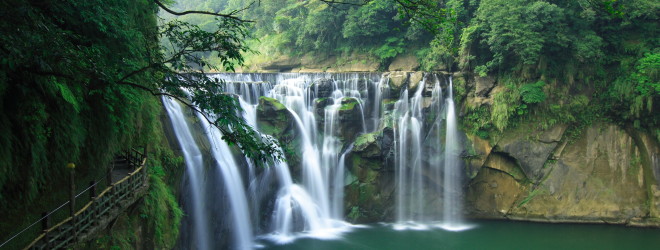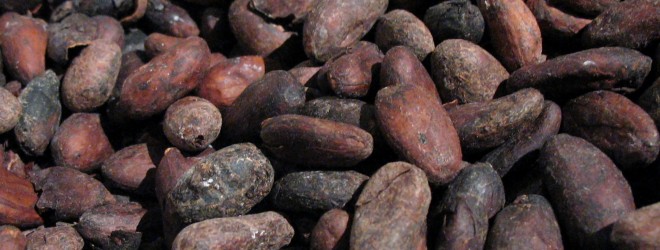Among the more common trees of my area is the Western Hemlock (Tsuga heterophylla), a large conifer in the Pine family (Pinaceae). It thrives in the cool, wet weather of the Pacific Northwest, its range extending from Oregon north into Alaska. Western Hemlock is a shade tolerant tree that is often found mixed with Douglas Fir (Pseudotsuga menziesii) and Western Red Cedar (Thuja plicata). It is easily distinguishable by its irregular, feathery needles that are smaller and softer than Douglas Fir needles, with a blunt tip. Looking at the trunk, young trees have a smooth, brownish-red colored bark, whereas older specimens become greyish-brown, with deep furrows, but not as thick, coarse and reddish colored like Douglas Fir – and not papery like Western Red Cedar. Locally, we have a closely related species that grows at higher elevations called Mountain Hemlock (Tsuga mertensiana), and the the difference between them is subtle: Mountain Hemlock has larger, open cones, whereas the cones on Western Hemlock are smaller, and more closed in appearance.
Western Hemlock is a tree of significant economic importance to the Canadian economy. Although it isn’t as strong as Douglas Fir, nor rot-resistant like Red Cedar, Western Hemlock still finds use as a building material and as a pulpwood for paper. For the First Nations peoples Western Hemlock was an important plant, more often used to make tools and cooking implements rather than as a building material. According to Pojar and McKinnon, the wood is fairly dense and heavy, and yet relatively easy to work with, making it useful to carve spoons, bowls, roasting spits, fish hooks and spearshafts. The tannin-rich bark yields a reddish dye, and this was used as a stain to treat wood and as a dye to color wool and other textiles.
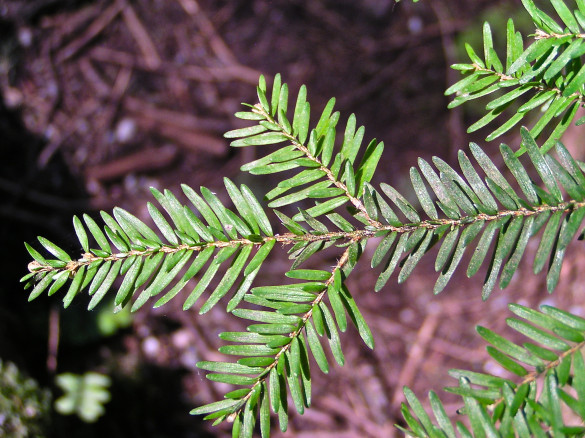
Looking at Western Hemlock, it is certainly seems to me to be the most feminine of the three species. One of the ways you can identify the tree from a distance is to look for its drooping tip, which seems to suggest a certain demure, yielding quality. Likewise, the tree’s love of the shade and moisture, as well we the feathery appearance of the boughs is another suggestion that Western Hemlock expresses a feminine, yin quality. It is perhaps no surprise that Western Hemlock was an important woman’s herb in the local Coastal Salish tradition. For example, boughs were often used to make special huts to house that the women gathered in during menstruation. Among the Kwakwaka’wakw people of Vancouver Island, female warriors asking a boon of the god Sisiutl used Western Hemlock in their head-dress during ceremonial dances. Sisiutl is the two-headed serpent mentioned in all the Coastal First Nations mythology: an untamed deity of the earth, representing like the Indian goddess Kali, the wild darkness of nature from which all life begins. It is no surprise then that as a tree of power, it is the most prolific tree here on the west coast, with the highest growth rate of any other local conifer. On a successional level, Western Hemlock represents a maturing forest that is rich in organic material, forming a thick, forest canopy under which very few things can grow. Its darkness is all encompassing.
One of Western Hemlock’s uses was a food, once again, representing the tree’s intimate association with the feminine quality of nourishment. Similar to herbs like Slippery Elm bark, Western Hemlock has a starchy, sweet inner bark that can be a significant source of food energy. The bark from the branches and trunks of younger trees can be easily peeled off, and the inner bark scraped with a knife. Coastal peoples including the Nisga’a and Gitksan steamed the inner bark and then pounded it into a paste to make cakes, often flavored with berries, and eaten with fish grease. In the spring, the sour tasting leaf buds are eaten as a spring tonic, and to balance the appetite. They are naturally rich in vitamin C, and can be eaten fresh or brewed as a tea. Western Hemlock of course is also an important medicine among the coastal First Nations peoples. Like many conifers, the sap or pitch is medicinal, used as a poultice to heal wounds and burns, as well as mixed with fat to form an aromatic salve that is useful as a chest rub for colds, to massage sore muscles, and to protect against sunburn. The bark is a strong astringent, traditionally used for problems such as internal hemorrhage and bleeding, used in tuberculosis, fever, and as a wash for skin sores and rashes. With a multitude of uses, in industry and as a food and medicine, Western Hemlock truly lives up to the meaning of its scientific name Tsuga, derived from the Japanese words for tree (tsu) mother (ga): the mother of trees.
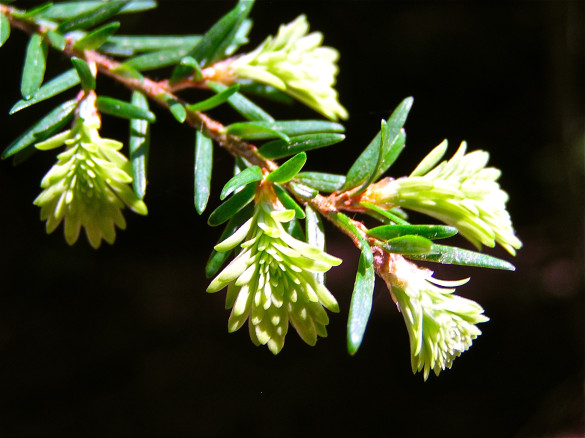
For more information on the traditional uses for this plant, search for Tsuga heterophylla at the Native American Ethnobotany Database.
